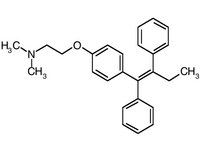Use of tamoxifen has reduced the rate of new cancers in breast cancer survivors by about 50 percent, leading to speculation that this drug could provide effective prophylaxis in women at high risk of developing breast cancer. Since the first pilot study of tamoxifen prophylaxis in 1986, four large international studies have produced mixed results, ranging from no effect to a 50 percent reduction in breast cancer incidence. The International Breast Cancer Intervention Study (IBIS-I) evaluated more than 7,000 women in Europe, Australia, and New Zealand to establish the risks and benefits of prophylactic treatment with tamoxifen to prevent breast cancer.
They studied women 35 to 70 years of age who had risk factors equivalent to a twofold relative risk for women 45 to 70 years of age, a fourfold relative risk for those 40 to 44 years of age, and a 10-fold relative risk for women 35 to 39 years of age. Reasons for exclusion from the study included previous cancer, thromboembolic disease, current use of anticoagulants, shortened life expectancy, and desire for future pregnancy. All participants had baseline mammographic and laboratory assessments. The women were then randomly assigned to treatment for five years with tamoxifen in a dosage of 20 mg per day or a matching placebo, and were followed every six months for five years.
Two thirds of participants had two or more first-degree or second-degree relatives with breast cancer, and overall, 97 percent reported some family history of breast cancer. After a median follow-up period of 50 months, 69 cases of breast cancer were detected in women assigned to tamoxifen and 101 in control subjects. This 32 percent reduction was evident for invasive and noninvasive cancers. Breast cancer reduction was not influenced by age or use of hormone replacement therapy. The reduction was limited to estrogen-receptor-positive tumors. Only four deaths occurred overall, whereas 9.5 were projected.
Postmenopausal women treated with tamoxifen had a nonsignificant excess of endometrial cancers but a significant excess of thromboembolic events. Almost one half of these events were associated with surgery or prolonged immobilization. The death rates for all causes were significantly higher in women treated with tamoxifen, because of excesses in pulmonary embolism, cardiac and vascular deaths, and other cancers.
The authors conclude that prophylactic tamoxifen reduces breast cancer risk by about one third but is associated with an unexpected increase in total deaths. They recommend that women who are at risk for thromboembolic disease not be considered for tamoxifen therapy and that tamoxifen prophylaxis be discontinued in women undergoing surgery or prolonged immobilization. Vigorous antithrombotic therapy should be instituted in such women.
COPYRIGHT 2003 American Academy of Family Physicians
COPYRIGHT 2003 Gale Group



